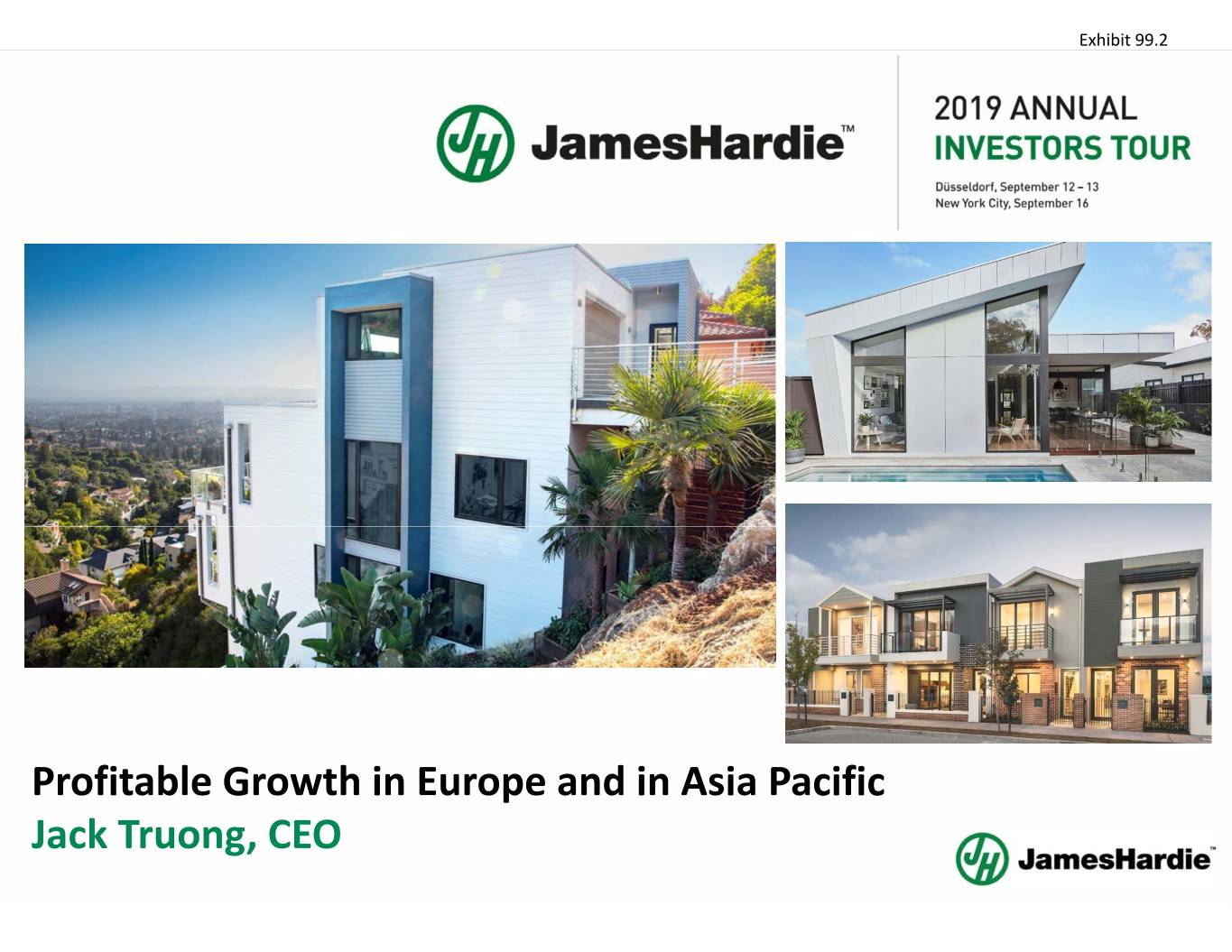
Exhibit 99.2 Profitable Growth in Europe and in Asia Pacific Jack Truong, CEO 1
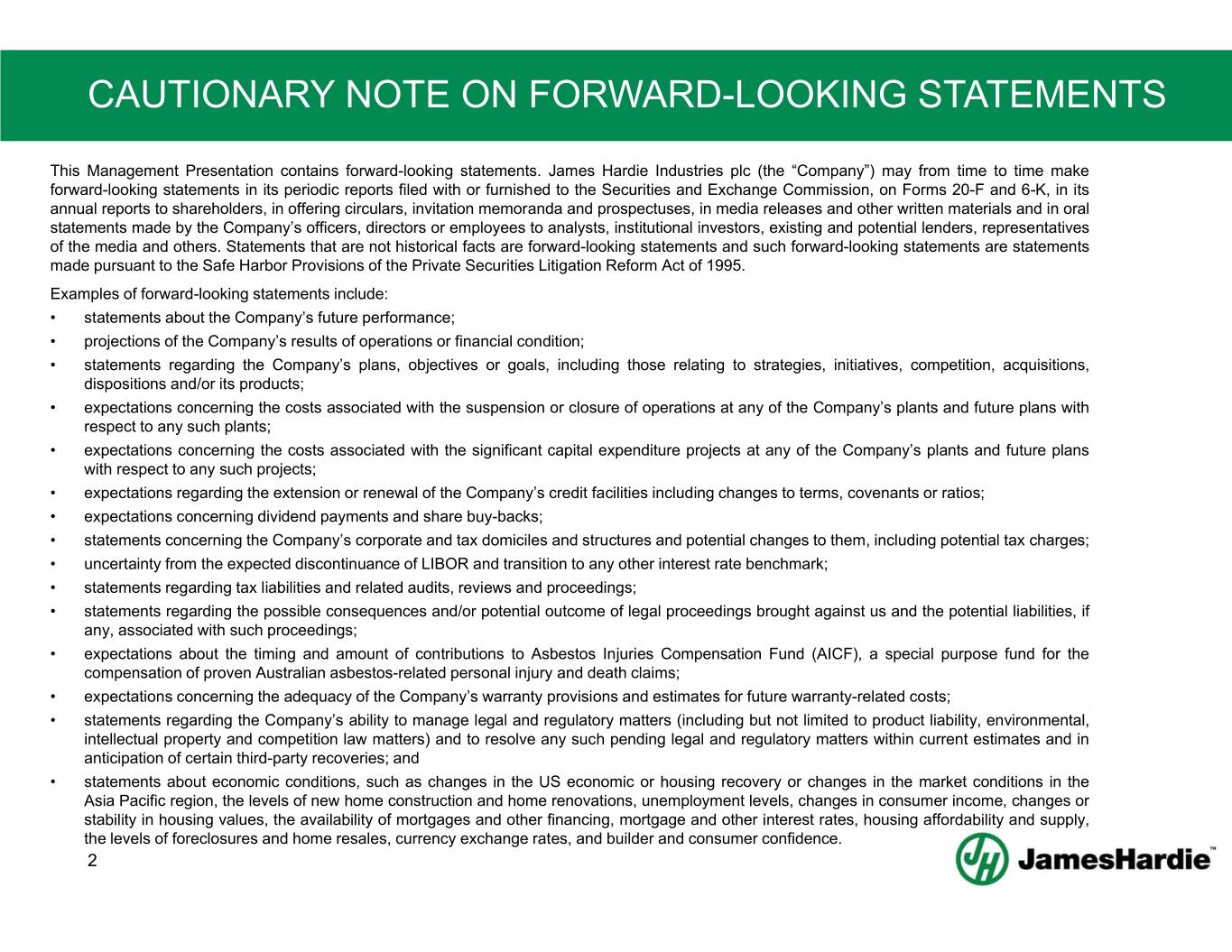
CAUTIONARY NOTE ON FORWARD-LOOKING STATEMENTS This Management Presentation contains forward-looking statements. James Hardie Industries plc (the “Company”) may from time to time make forward-looking statements in its periodic reports filed with or furnished to the Securities and Exchange Commission, on Forms 20-F and 6-K, in its annual reports to shareholders, in offering circulars, invitation memoranda and prospectuses, in media releases and other written materials and inoral statements made by the Company’s officers, directors or employees to analysts, institutional investors, existing and potential lenders, representatives of the media and others. Statements that are not historical facts are forward-looking statements and such forward-looking statements are statements made pursuant to the Safe Harbor Provisions of the Private Securities Litigation Reform Act of 1995. Examples of forward-looking statements include: • statements about the Company’s future performance; • projections of the Company’s results of operations or financial condition; • statements regarding the Company’s plans, objectives or goals, including those relating to strategies, initiatives, competition, acquisitions, dispositions and/or its products; • expectations concerning the costs associated with the suspension or closure of operations at any of the Company’s plants and future plans with respect to any such plants; • expectations concerning the costs associated with the significant capital expenditure projects at any of the Company’s plants and future plans with respect to any such projects; • expectations regarding the extension or renewal of the Company’s credit facilities including changes to terms, covenants or ratios; • expectations concerning dividend payments and share buy-backs; • statements concerning the Company’s corporate and tax domiciles and structures and potential changes to them, including potential tax charges; • uncertainty from the expected discontinuance of LIBOR and transition to any other interest rate benchmark; • statements regarding tax liabilities and related audits, reviews and proceedings; • statements regarding the possible consequences and/or potential outcome of legal proceedings brought against us and the potential liabilities, if any, associated with such proceedings; • expectations about the timing and amount of contributions to Asbestos Injuries Compensation Fund (AICF), a special purpose fund for the compensation of proven Australian asbestos-related personal injury and death claims; • expectations concerning the adequacy of the Company’s warranty provisions and estimates for future warranty-related costs; • statements regarding the Company’s ability to manage legal and regulatory matters (including but not limited to product liability, environmental, intellectual property and competition law matters) and to resolve any such pending legal and regulatory matters within current estimates and in anticipation of certain third-party recoveries; and • statements about economic conditions, such as changes in the US economic or housing recovery or changes in the market conditions in the Asia Pacific region, the levels of new home construction and home renovations, unemployment levels, changes in consumer income, changes or stability in housing values, the availability of mortgages and other financing, mortgage and other interest rates, housing affordability and supply, the levels of foreclosures and home resales, currency exchange rates, and builder and consumer confidence. 2
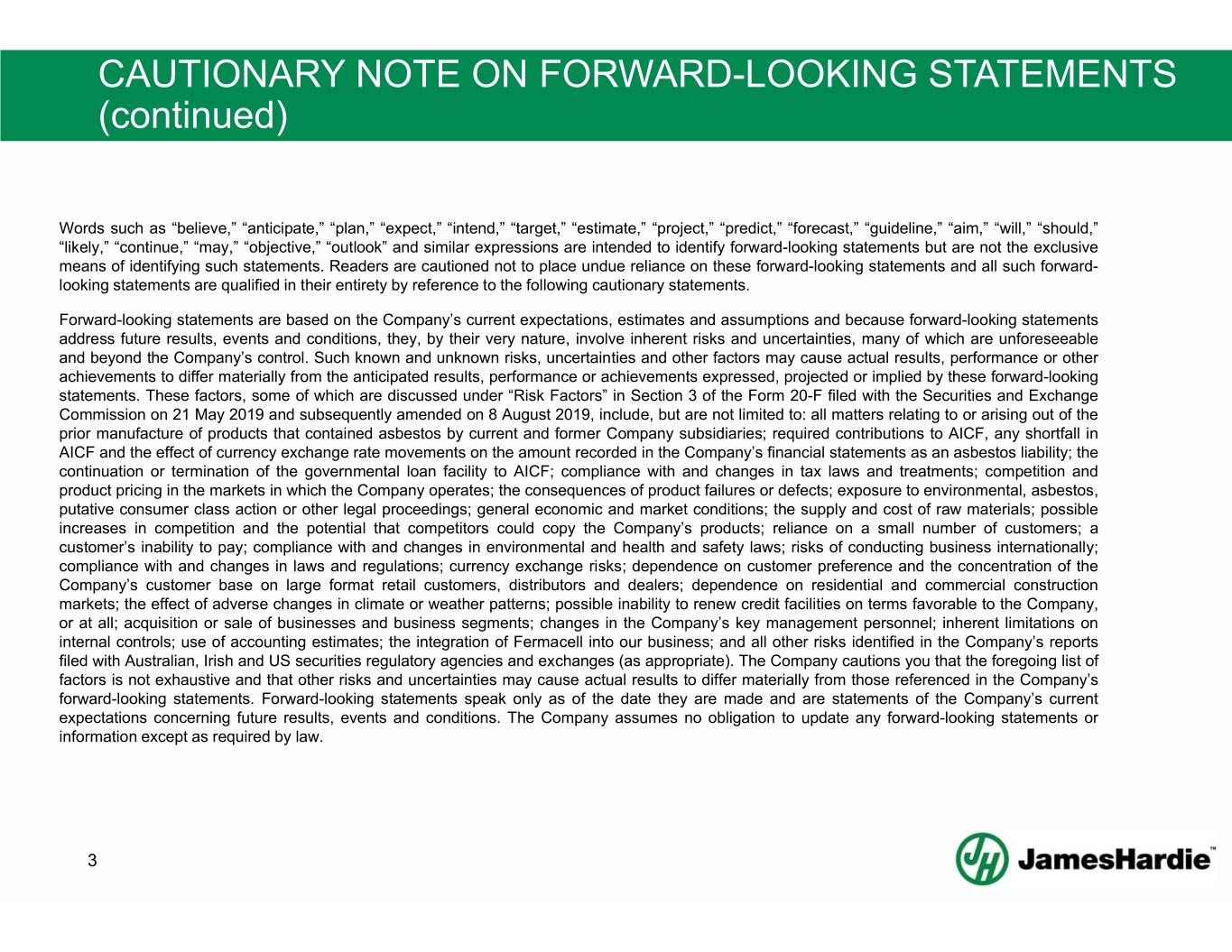
CAUTIONARY NOTE ON FORWARD-LOOKING STATEMENTS (continued) Words such as “believe,” “anticipate,” “plan,” “expect,” “intend,” “target,” “estimate,” “project,” “predict,” “forecast,” “guideline,” “aim,” “will,” “should,” “likely,” “continue,” “may,” “objective,” “outlook” and similar expressions are intended to identify forward-looking statements but are not the exclusive means of identifying such statements. Readers are cautioned not to place undue reliance on these forward-looking statements and all such forward- looking statements are qualified in their entirety by reference to the following cautionary statements. Forward-looking statements are based on the Company’s current expectations, estimates and assumptions and because forward-looking statements address future results, events and conditions, they, by their very nature, involve inherent risks and uncertainties, many of which are unforeseeable and beyond the Company’s control. Such known and unknown risks, uncertainties and other factors may cause actual results, performance or other achievements to differ materially from the anticipated results, performance or achievements expressed, projected or implied by these forward-looking statements. These factors, some of which are discussed under “Risk Factors” in Section 3 of the Form 20-F filed with the Securities and Exchange Commission on 21 May 2019 and subsequently amended on 8 August 2019, include, but are not limited to: all matters relating to or arising out of the prior manufacture of products that contained asbestos by current and former Company subsidiaries; required contributions to AICF, any shortfall in AICF and the effect of currency exchange rate movements on the amount recorded in the Company’s financial statements as an asbestos liability; the continuation or termination of the governmental loan facility to AICF; compliance with and changes in tax laws and treatments; competition and product pricing in the markets in which the Company operates; the consequences of product failures or defects; exposure to environmental, asbestos, putative consumer class action or other legal proceedings; general economic and market conditions; the supply and cost of raw materials; possible increases in competition and the potential that competitors could copy the Company’s products; reliance on a small number of customers; a customer’s inability to pay; compliance with and changes in environmental and health and safety laws; risks of conducting business internationally; compliance with and changes in laws and regulations; currency exchange risks; dependence on customer preference and the concentration of the Company’s customer base on large format retail customers, distributors and dealers; dependence on residential and commercial construction markets; the effect of adverse changes in climate or weather patterns; possible inability to renew credit facilities on terms favorable to the Company, or at all; acquisition or sale of businesses and business segments; changes in the Company’s key management personnel; inherent limitations on internal controls; use of accounting estimates; the integration of Fermacell into our business; and all other risks identified in the Company’s reports filed with Australian, Irish and US securities regulatory agencies and exchanges (as appropriate). The Company cautions you that the foregoing listof factors is not exhaustive and that other risks and uncertainties may cause actual results to differ materially from those referenced in the Company’s forward-looking statements. Forward-looking statements speak only as of the date they are made and are statements of the Company’s current expectations concerning future results, events and conditions. The Company assumes no obligation to update any forward-looking statements or information except as required by law. 3
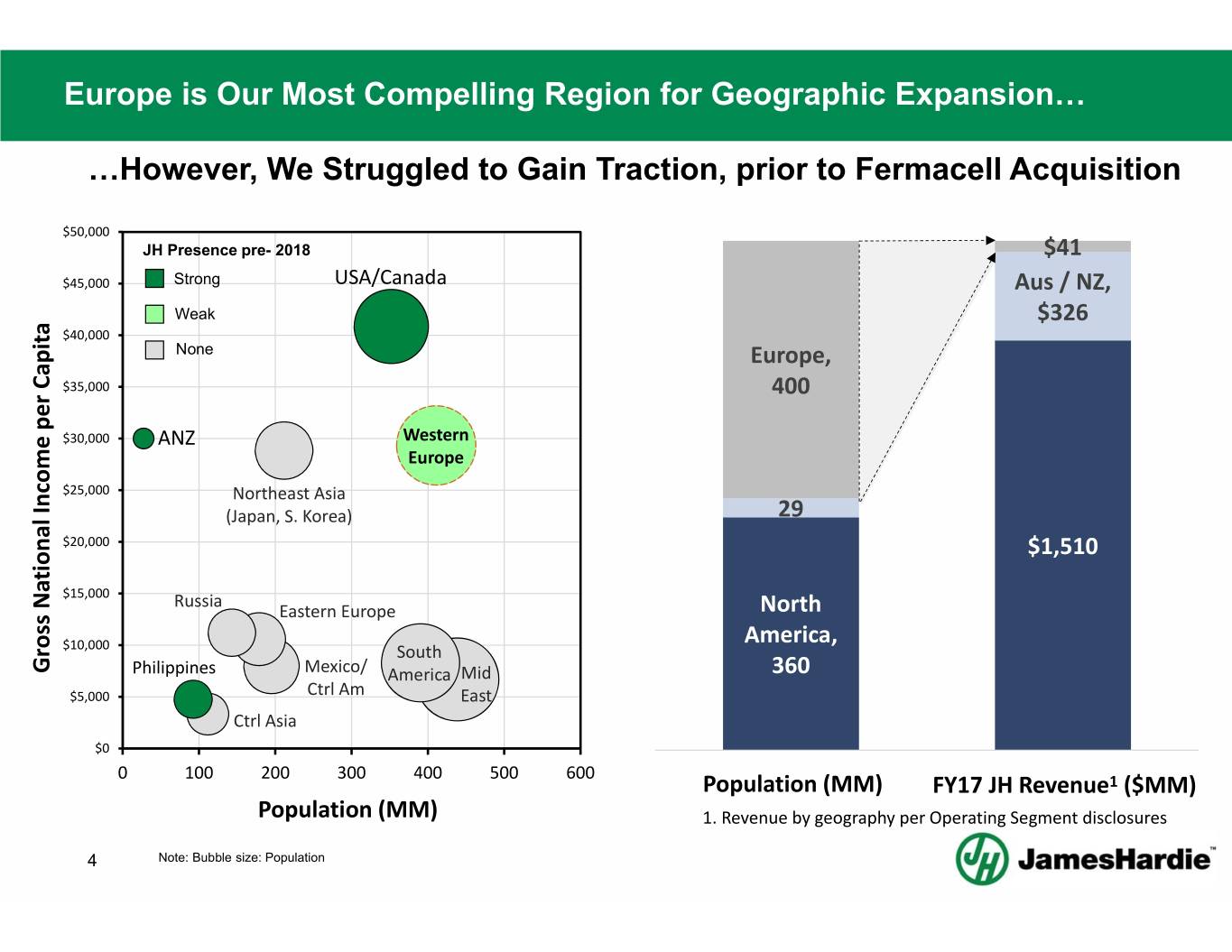
Europe is Our Most Compelling Region for Geographic Expansion… …However, We Struggled to Gain Traction, prior to Fermacell Acquisition $50,000 JH Presence pre- 2018 $41 $45,000 Strong USA/Canada Aus / NZ, Weak $326 $40,000 None Europe, $35,000 400 $30,000 ANZ Western Europe $25,000 Northeast Asia (Japan, S. Korea) 29 $20,000 $1,510 $15,000 Russia Eastern Europe North America, $10,000 South Gross National Income per Capita Philippines Mexico/ America Mid 360 $5,000 Ctrl Am East Ctrl Asia $0 0 100 200 300 400 500 600 2016 Population (mm)Population (MM) FY17 JH Revenue FY17 JH Revenue ($mm)1 ($MM) Population (MM) 1. Revenue by geography per Operating Segment disclosures 4 Note: Bubble size: Population
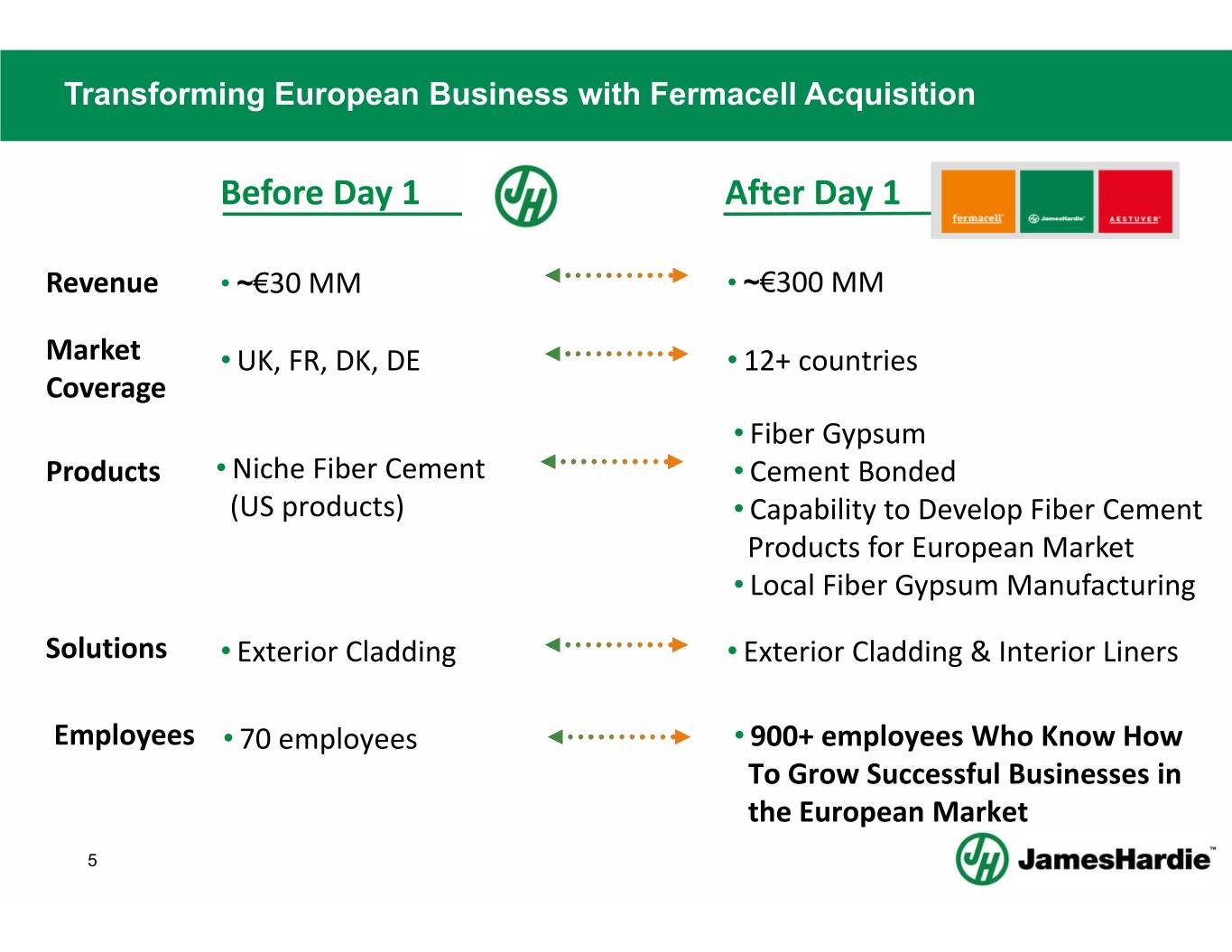
Transforming European Business with Fermacell Acquisition Before Day 1 After Day 1 Revenue • ~€30 MM • ~€300 MM Market • UK, FR, DK, DE • 12+ countries Coverage • Fiber Gypsum Products • Niche Fiber Cement • Cement Bonded (US products) • Capability to Develop Fiber Cement Products for European Market • Local Fiber Gypsum Manufacturing Solutions • Exterior Cladding • Exterior Cladding & Interior Liners Employees • 70 employees • 900+ employees Who Know How To Grow Successful Businesses in the European Market 5

We Are an Organic Growth Company with Global Reach… EUROPE Net Sales $368MM EBIT $10MM EBIT % 2.7% # Employees 1,000 EBIT included Integration costs ASIA PACIFIC NORTH AMERICA Net Sales $447MM Net Sales $1,677MM EBIT $100MM EBIT $388MM EBIT % 22.3% EBIT % 23.1% # Employees 1,100 # Employees 2,700 FY 2019 Actual Results WORLDWIDE Net Sales $2,507MM EBIT $405MM EBIT % 16.1% 6 # Employees 4,800
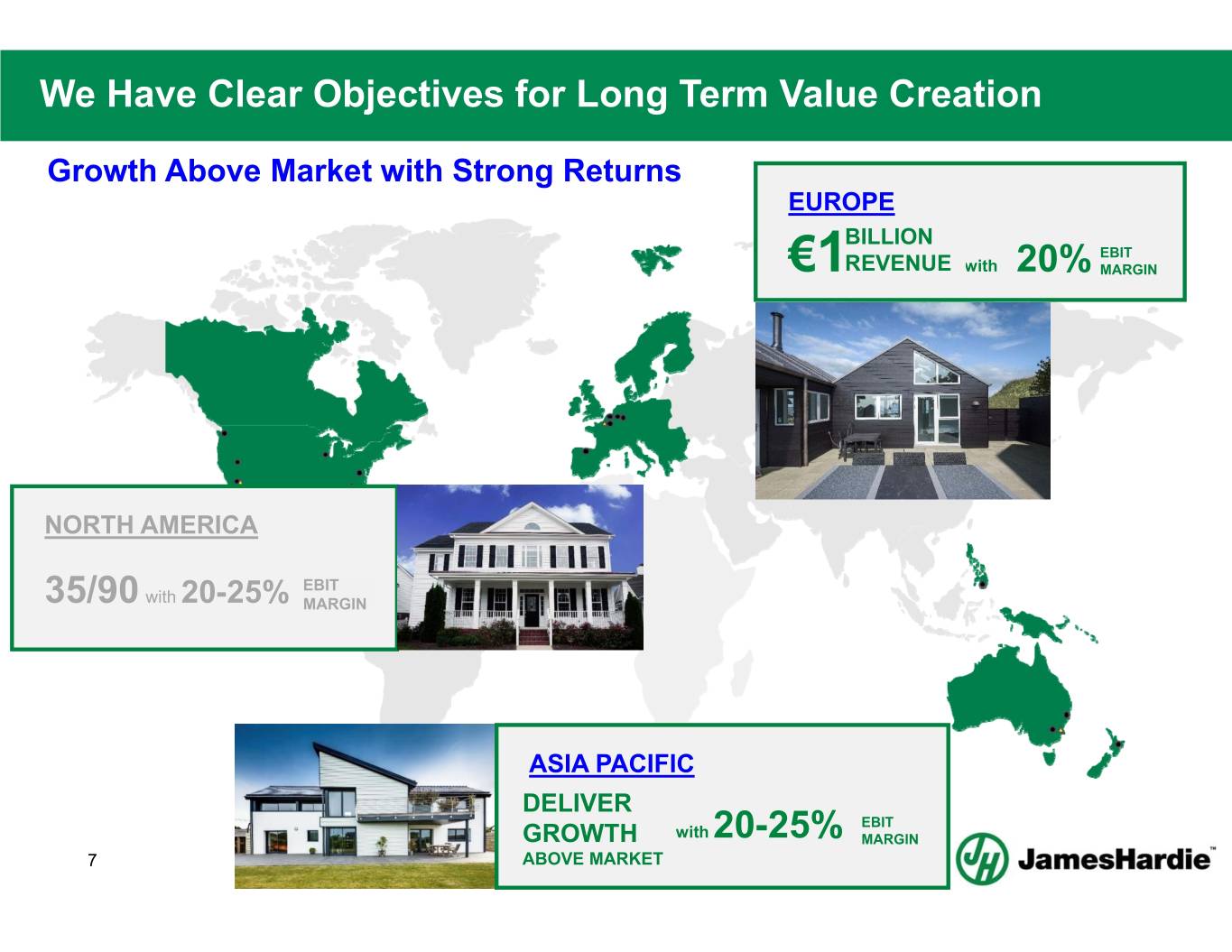
We Have Clear Objectives for Long Term Value Creation Growth Above Market with Strong Returns EUROPE BILLION EBIT €1REVENUE with 20% MARGIN NORTH AMERICA EBIT 35/90 with 20-25% MARGIN ASIA PACIFIC DELIVER EBIT GROWTH with 20-25% MARGIN 7 ABOVE MARKET
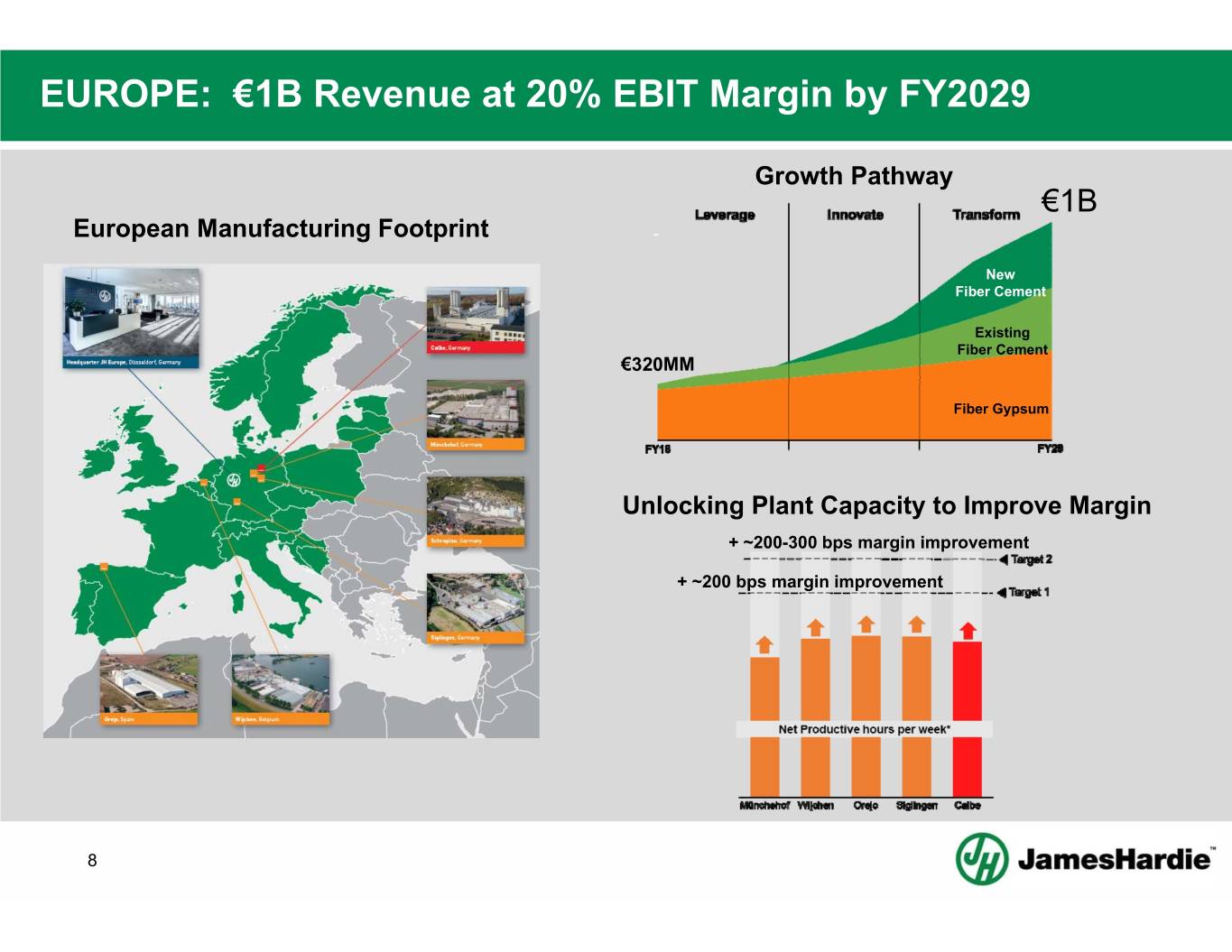
EUROPE: €1B Revenue at 20% EBIT Margin by FY2029 Growth Pathway €1B European Manufacturing Footprint New Fiber Cement Existing Fiber Cement €320MM Fiber Gypsum Unlocking Plant Capacity to Improve Margin + ~200-300 bps margin improvement + ~200 bps margin improvement 8
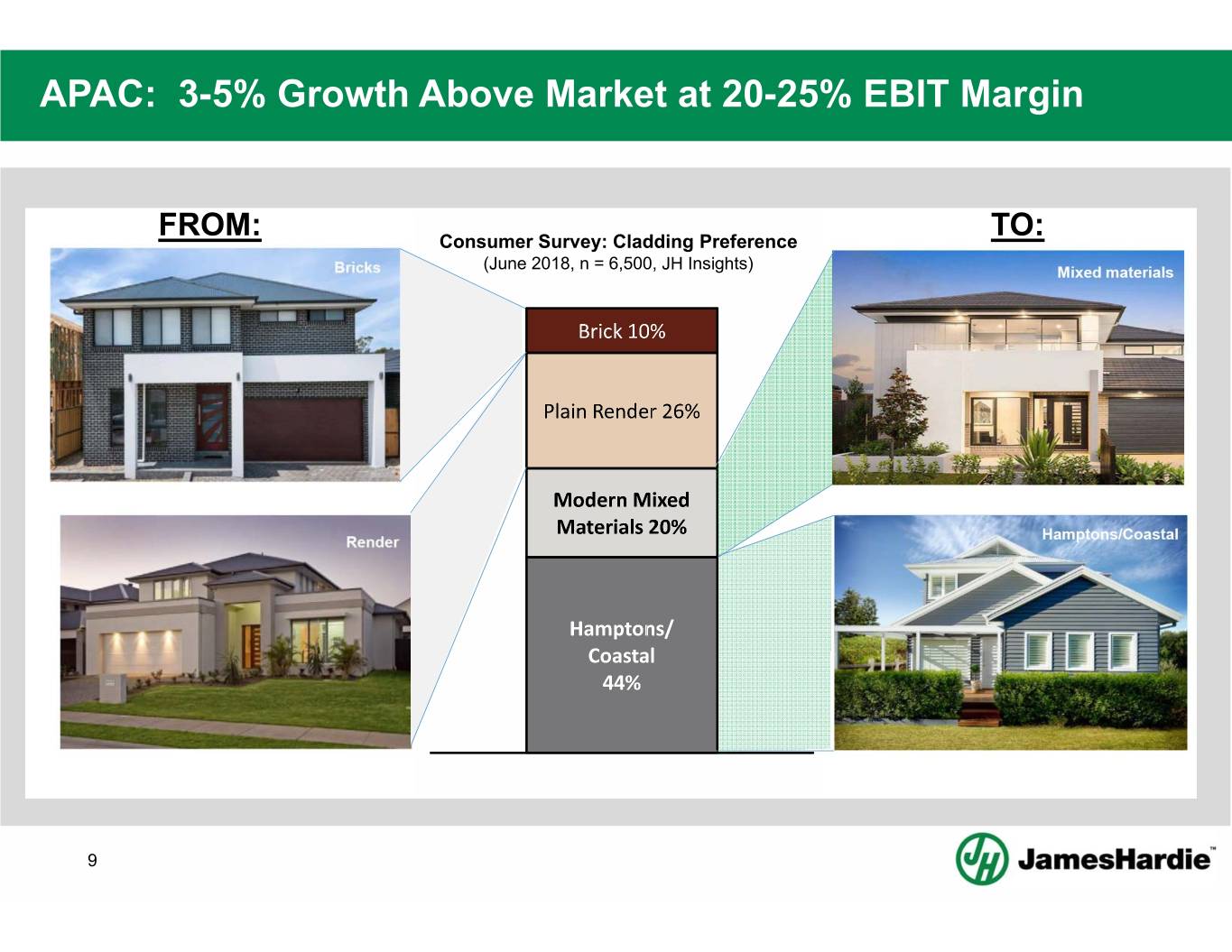
APAC: 3-5% Growth Above Market at 20-25% EBIT Margin FROM: TO: Consumer Survey: Cladding Preference (June 2018, n = 6,500, JH Insights) 9
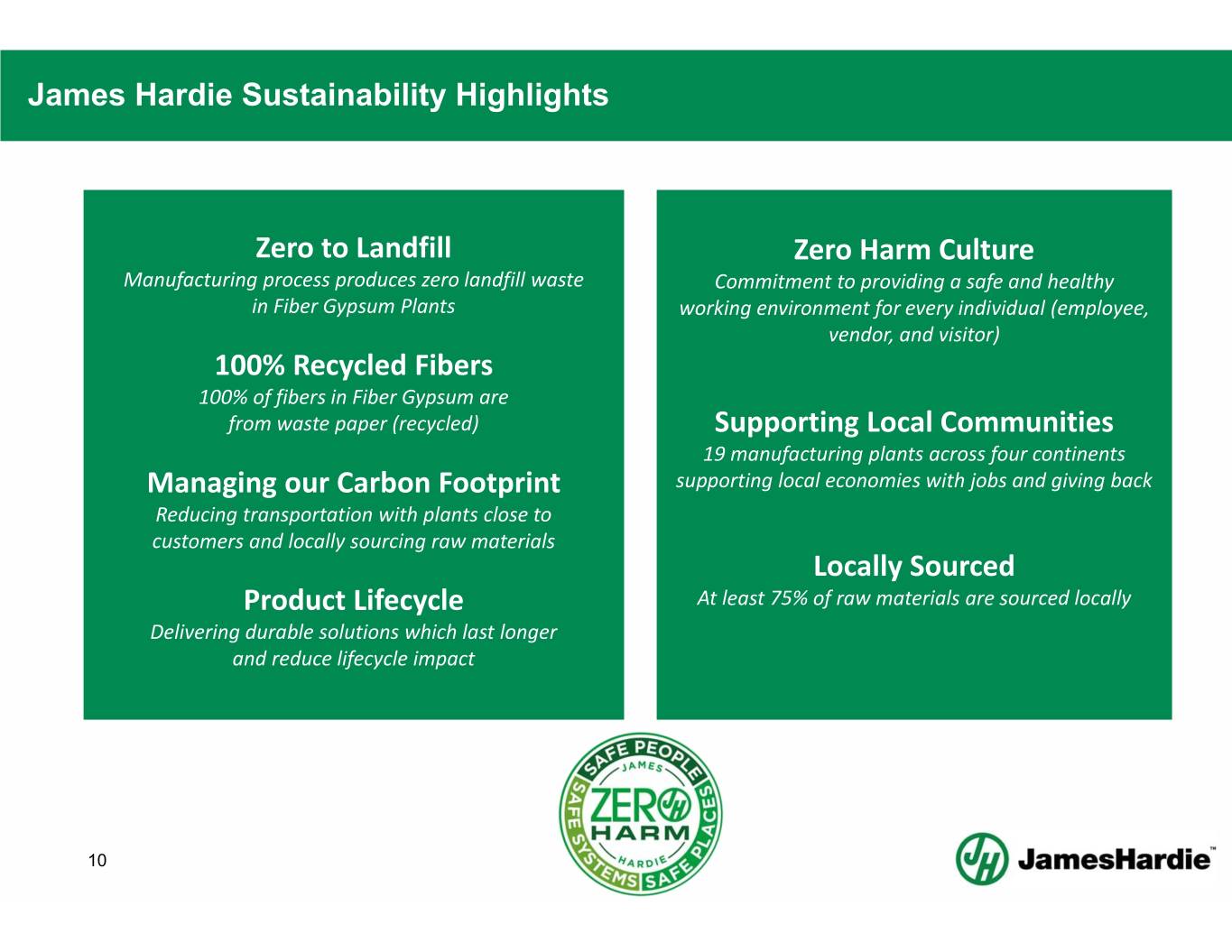
James Hardie Sustainability Highlights Zero to Landfill Zero Harm Culture Manufacturing process produces zero landfill waste Commitment to providing a safe and healthy in Fiber Gypsum Plants working environment for every individual (employee, vendor, and visitor) 100% Recycled Fibers 100% of fibers in Fiber Gypsum are from waste paper (recycled) Supporting Local Communities 19 manufacturing plants across four continents Managing our Carbon Footprint supporting local economies with jobs and giving back Reducing transportation with plants close to customers and locally sourcing raw materials Locally Sourced Product Lifecycle At least 75% of raw materials are sourced locally Delivering durable solutions which last longer and reduce lifecycle impact 10